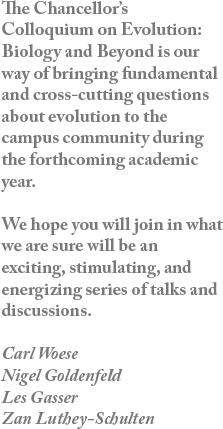Upcoming Events
April 27th
Jan SappProfessor, History of Biology, York University, Toronto, Canada
The New Foundations of Evolution: On the Tree of Life
4:00pm @ 101 Armory
Past Events
April 13th
Forest RohwerProfessor, San Diego State University
"Natural Selection" Revisited: Are There Really Winners in Evolution?
4:00pm @ Loomis 151
March 1st
Rudy RaffDistinguished Professor of Biology, Indiana University
Microbes and Fossils: Hunting the First Embryosbr />
February 17th
Ed DeLongDepartment of Biological Engineering, MIT
Illuminating the Microbial World: The Key to Understanding the Evolution and Ecology of the Living Earth System
November 2nd
Thomas Roy DaviesAuthor and BBC Producer, Director, and Writer
The Darwin Conspiracy
October 12th
Laura LandweberProfessor of Ecology & Evolutionary Biology at Princeton University
The Evolution of Cellular Computing: A Modern Take on Lamarckian Inheritance
September 30th
George DysonHistorian and Philosopher of Science
Von Neumann's Universe:
Computers & Beyond
September 29th
George DysonHistorian and Philosopher of Science
Darwin Among the Machines:
From Zoonomia to Artificial Life
Events
The New Foundations of Evolution: On the Tree of Life
April 27, 2010 4:00pm @ 101 Armory
Jan Sapp
Professor, History of Biology, York University, Toronto, Canada
While molecular phylogenetics has greatly advanced our understanding of animals and plants, it is its application to the microbial world that has had by far the greatest impact on our understanding of life and its evolution and will allow biologists to approach and understand evolution in a far more profound way than had previously been possible. My lecture will take us on a tour of the historical development of microbial taxonomy as it can now be seen through the eye of molecular phylogeny. Not only has the discovery of the three fundamental domains of life effectively opened a new continent to evolutionary study, but the continuation of these studies is beginning to probe the depths of the evolutionary ocean in which modern life today floats.
"Natural selection" revisited: are there really winners in evolution?
April 13, 2010 4:00pm @ Loomis 151
Forest Rohwer
Professor, San Diego State University
Wallace and Darwin both recognized that Malthusian (exponential) growth rapidly leads to unsustainably large populations. This unsustainability means that individuals in these populations must compete for resources. Since some individuals are better competitors, it seems reasonable to assume that their off-spring will correspondingly be more numerous. Evolutionary biology grew out of this simple logic, often referred to as "Natural Selection", despite Wallace's objections. However, Wallace and Darwin could not know that most of biology and evolution occurs outside the realm of our five senses --- a bias that persists with less justification even amongst most modern-day scientists. In fact, the dominant organisms on Earth, by essentially any measure, are the viruses. They were present at the beginning of life and they will be the last relics of life when the planet dies. If there can be said to be winners in the evolutionary struggle to be the most successful organisms, then they must be the viruses. I will expand upon this thesis and along the way describe the latest research on the impact of viruses on everything from the global climate to human biology. As the web of viral complexity is revealed, it becomes increasingly clear that we must view viruses in a multi-faceted way, not only as winners (i.e. predators), but also as the communal glue in a great global microbial network. To some extent, Nature may indeed be "Red in tooth and claw". However, when Lord Tennyson penned these words, he did not know that the teeth are actually endonucleases and the claws are tail fibers.
Microbes and Fossils: Hunting the First Embryos
March 1, 2010 4:00pm @ LIB 66
Rudy Raff
Distinguished Professor of Biology, Indiana University
The fossil record provides us with much of our information about evolutionary history. However, to interpret that record fully, we have to apply our knowledge of biological processes. I'll discuss two approaches to understanding the record of the first animals. I'll outline how the rapid evolution of larval forms going on today gives a perspective on the evolution of the embryos of early animals. The more direct approach is to understanding how the fossils of the first soft-bodied animals and, more surprisingly, their embryos have come down to us. We have approached this problem by investigating the early steps of fossilization as the consequence of the work of bacteria that in a few days stabilize form and deposit minerals. DNA tools allow rapid identification of the bacteria involved.
Illuminating the Microbial World: The Key to Understanding the Evolution and Ecology of the Living Earth System
February 17, 2010 4:00pm @ DCL 1320
Ed DeLong
Department of Biological Engineering, MIT
Despite the central importance of the microbial world to the biosphere, its complexity and evolution remain shrouded in mystery. However, with major advances in genome technology and theoretical modeling, our understanding and appreciation of the biosphere is undergoing an exciting revolution. This lecture will give a broadly accessible overview of these developments. In particular, I will describe how genetic inventories of whole communities, single-cell genomics and mathematical modeling of the simultaneous interplay between all levels of biological organization—from genomes to ecosystems—are beginning to provide a clear picture of the microbial collectives that maintain global cycles of energy and material. Together these new advances, experimental and theoretical, paint a compelling picture of the emergent properties of microbial communities that dominate the evolutionary and ecological processes of our living planet Earth.
The Darwin Conspiracy
November 2, 2009 7:00pm @ Loomis 141
Thomas Roy Davies
Author and BBC Producer, Director, and Writer
Charles Darwin has been hailed as the greatest scientist of the 19th century for his discovery of the secrets of evolution. Today the impact of his work is still felt throughout the world. But did Darwin really come up with the mechanisms of evolution himself or did he take it from a young researcher---Alfred Russel Wallace---trying to impress him? The Darwin Conspiracy examines how Darwin struggled for years in scientific dead-ends until in 1858 he received a letter from Wallace which presented the solution to the roadblock that had stumped his progress. The subsequent and unauthorized presentation of Wallace’s results, along with selections of Darwin’s writings, to the Linnean Society on 1st July 1858, by Sir Charles Lyell and Joseph Hooker, began the conspiracy by which these eminent scientists promoted the ideas of Darwin ahead of those of Wallace in order to achieve ever-lasting fame for their greatest friend. By reviewing the work of many distinguished academics who have raised questions about the origins of Darwin’s ideas, and by following the detailed paper trail of letters between Wallace and Darwin with new and extensive research into contemporary shipping time tables, this lecture challenges the commonly-held belief that Darwin scored a scientific breakthrough. In reality Darwin used another man's insights for his own benefit, and committed one of the greatest scientific crimes in history. The Darwin Conspiracy is a true story about deceit and deception and stands as an outstanding metaphor for the idea of survival of the fittest.
The evolution of cellular computing: A modern take on Lamarckian inheritance
October 12, 2009 7:00pm @ DCL 1320
Laura Landweber
Professor of Ecology & Evolutionary Biology at Princeton University
2009 marks not only the 200th anniversary of Darwin's birth but also publication of the first evolutionary theory, Lamarck's Philosophie Zoologique. "Lamarckian evolution" is usually distinguished from "Darwinian evolution" by its reliance on the inheritance of acquired characteristics, and as such, is usually dismissed as lacking a sound biological basis. However, there is increasingly compelling evidence for a variety of molecular mechanisms that can support Lamarckian modes of evolution. In this talk, I will discuss our recent work with pond organisms, known as ciliates, demonstrating an extraordinary new role for the molecule RNA. Normally thought of as a conduit in gene expression, in ciliates, RNA can provide both an organizing role in DNA rearrangements and a template for transmitting mutations to the next generation. Understanding how information is encoded to reorder genome fragments highlights the deep connections between computational and genomic processes. I explain how a transiently-expressed cache of non-coding RNAs may provide the programming instructions for genome remodeling and transmit heritable information. The occasional transfer of point mutations from these RNA templates to rearranged DNA molecules supplies a viable mechanism for stable inheritance of acquired characters. This mechanism for inheritance beyond the conventional DNA genome can pass information across multiple generations, hinting at the power of RNA molecules to reshape genome information.
Von Neumann's Universe: Computers & Beyond
September 30, 2009 4:00pm @ Gregory 100
George Dyson
Historian and Philosopher of Science
Exactly 60 years ago, Hungarian-American mathematician John von Neumann delivered five lectures on the "Theory and Organization of Complex Automata" at the University of Illinois. The digital computer being constructed under von Neumann‚s direction at the Institute for Advanced Study in Princeton, New Jersey (and cloned simultaneously at the University of Illinois) would not be completed until 1951, and the structure of DNA would not be elucidated until 1953, yet the foundations of the digital and genetic revolutions were already on solid theoretical ground in 1949.
A digital universe consists of two species of bits: differences in space and differences in time. Digital computers are devices that translate between these two forms of information--structure and sequence--according to definite rules. The stored-program computer, as conceived by Alan Turing and delivered by John von Neumann, broke the distinction between numbers that mean things and numbers that do things. Our universe would never be the same. Turing's question was whether machines would begin to think. Von Neumann's question was whether machines would begin to reproduce.
Von Neumann succeeded in jump-starting the computer revolution by bringing engineers into the den of the mathematicians, rather than by bringing mathematicians into a den of engineers. With 5 kilobytes of storage, von Neumann and colleagues tackled previously intractable problems ranging from thermonuclear explosions, stellar evolution, and long-range weather forecasting to cellular automata, genetic coding, and the origins of life. Programs were small enough to be completely debugged, but hardware could not be counted on to perform consistently from one kilocycle to the next. This situation is now reversed.
Darwin Among the Machines:
From Zoonomia to Artificial Life
September 29, 2009 7:00pm @ Loomis 141
George Dyson
Historian and Philosopher of Science
Erasmus Darwin (1731-1802) framed the evolutionary synthesis that would be brought to fruition by his grandson Charles, while engaged firsthand in the industrial revolution that set biology and technology on a collision course.
After reading On the Origin of Species in a sheepherder‚s hut in New Zealand in 1860, the 25-year-old Samuel Butler—Darwin's ablest critic—became obsessed with the under-acknowledged antecedents of Charles Darwinism, and the beyond-Darwinian evolution of technology that lay ahead. Samuel Butler's "Darwin Among the Machines" of 1863 hinted at a future that already includes the decoding (and encoding) of operating instructions for biological life, and the exchange of these instructions between species and across time.
Organisms learned to survive in a noisy, analog environment by passing themselves, once a generation, through a digital, error- correcting phase, the same way repeater stations are used to convey intelligible messages over submarine cables where noise is being introduced. A world that was digital once a generation is now all digital, all the time. The era of strictly Darwinian evolution is drawing to a close.


